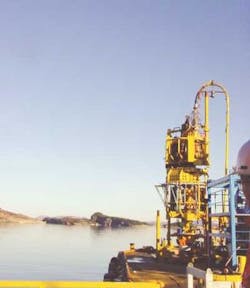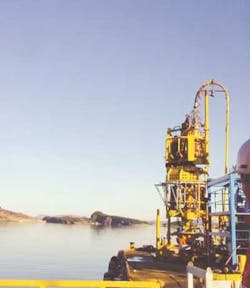FMC Kongsberg rolls out new subsea technology
FMC Kongsberg Subsea (FKS) is rolling out new technology developed under the SmartFields initiative. SmartFields embraces a suite of new technologies – subsea pro-cessing, downhole systems (SmartWells), subsea control systems (SmartControls), and light subsea well intervention systems designed to lift subsea oil and gas production to a new plane.
While there is a global approach to technology development in the FMC Energy Systems group, FKS is responsible for heading up the development of subsea technology. This was the field in which, as Kongsberg Offshore, it originally made its name before joining FMC Technologies Inc.
SmartFields date back to 1997 when the company set its sights on technology for increased oil recovery from subsea wells. Sponsorship for the initiative has been provided by Statoil and Norske Shell, two of the joint industry project partners that backed the development of the company's trademark hinge-over subsea template technology.
"We like to work in this kind of setting, and not only because of the funding it brings," Selvig says. "It means we have a clear customer need at the end, so we know we will hit the market needs." Some of the projects included in the initiative have also received funding from the Norwegian government's Demo 2000 program.
Under the category of subsea processing, the company has delivered equipment to a number of subsea multiphase pumping projects. These include one system to Shell's Draugen field off Norway, six systems to Statoil's Lufeng 22-1 development off China, and two systems to ExxonMobil's Topacio field off Equatorial Guinea. All these deliveries were made in conjunction with Framo Engineering, which supplied the pumps while FKS provided the subsea production equipment and systems integration.
Equipment for FKS's venture into subsea well intervention underwent testing in Bergen earlier this year.
FKS has also delivered a number of downhole pumping systems, including 25 systems supplied to Amoco's Liuhua field off China, and three systems supplied to TotalFinaElf's Otter project in the UK sector in 2001/02. The Otter delivery included a control system for the downhole pumps that incorporates a subsea electrical switch operated from the host platform.
In 2001 the company delivered the control system for a vertical annulus separation and pumping system for gas/liquid separation for Petrobras.
FKS is now working with a number of partners, though it declines to identify them at present, to develop a full subsea processing system based on a semi-compact separation concept. FKS itself has responsibility for marinization, provision of auxiliary systems and instrumentation, and integration of the package.
Critical components and subsystems for a subsea water removal system are currently undergoing qualification, and the R&D project is scheduled to be completed later this year, Selvig says. The system, which is designed for water depths down to 2,000 m, has been evaluated by Statoil as part of the Norne Technology Project and prequalified for possible use in the upcoming development of satellite fields in the Norne area.
Other SmartFields products now becoming available include the KOS 200 subsea monitoring and control system developed under the SmartControls project. KOS 200 provides increased data transmission speed and data processing capacity from downhole and subsea instruments and a means of controlling production through the operation of downhole and subsea equipment. The first delivery is to be made to Norsk Hydro's Fram Vest subsea development in the Norwegian sector this spring.
FKS is committed to forming long-term partnerships with companies that have an excellent track record in the relevant niches, according to Selvig.
"With these kinds of complex technologies embedded in a subsea processing system, it's not possible for one company to cope with all the products – it's better to team up and form a cluster," he says.
A team approach also characterizes a new FKS initiative that takes it into light subsea well intervention. Here the company is working with Halliburton and Prosafe, whose semisubmersible rig Regalia was recently modified for this work. Given the lower recovery rates traditionally associated with subsea wells, customers have much to gain from an economic subsea well maintenance service. Intervention also provides the opportunity to retrofit advanced downhole equipment.
FKS's contribution to the cooperative venture is the intervention equipment, including a subsea lubricator system it has developed and which earlier this year underwent testing on a dummy well near Bergen. A key feature of the system is that it does not involve circulating hydrocarbons to the surface, which means the vessel that will deploy it does not need to be classed as a drilling rig. Once final tests have been completed, the team will carry out four subsea well interventions for Statoil in the Norwegian sector.
The maintenance and modification of subsea facilities is another important focus for FKS, Selvig says. This is quite natural given the large number of subsea tree systems – 810 in total – that the company has delivered around the world.
A good example is the use of sand detectors and electrical actuators on chokes to allow the continuous and optimized adjustment of production in real-time from the host platform. FKS has developed such a retrofit system for Statoil. Instrumentation such as pressure/temperature sensors is normally only used to monitor the production from the different subsea wells, but can also contribute to optimizing individual well production through integration of the pressure and temperature measurements into software optimization systems. This capability is available at FKS following its takeover of Loke, a company specializing in production optimization software.
With a 38% market share, FKS claims to be the leading supplier of subsea production systems. Current deliveries include high-profile projects such as BP's Thunder Horse development and Shell's Na Kika, both in the Gulf of Mexico in 2,000-m water depth, and Petrobas' Roncador field in 1,800 m in the Campos basin. In the Angolan sector, it is supplying the subsea production facilities for TFE's Jasmim development and making additional deliveries to TFE's Girassol field.
Additional deliveries are also being made to ExxonMobil's Zafiro and Topacio fields off Equatorial Guinea, while deliveries to current Norwegian sector projects include Mikkel, Åsgard, Gullfaks, Heidrun, Statfjord, and Norne, all operated by Statoil, Hydro's Fram Vest and Oseberg J, ExxonMobil's Sigyn, and Norske Shell's Draugen.

